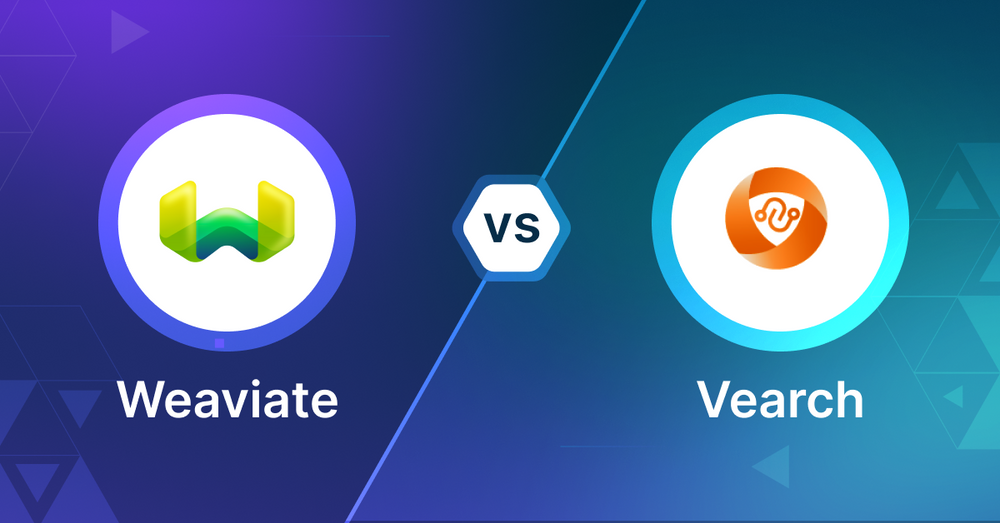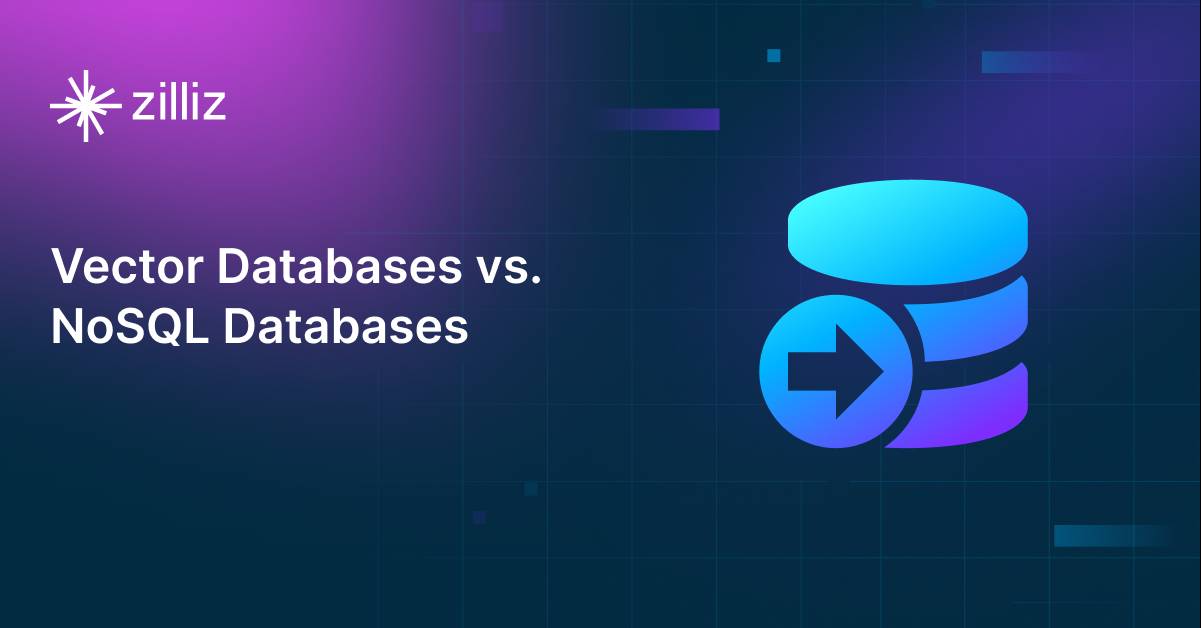Weaviate vs Vearch: Choosing the Right Vector Database for Your Needs

What is a Vector Database?
Before we compare Weaviate and Vearch, let's first explore the concept of vector databases.
A vector database is specifically designed to store and query high-dimensional vectors, which are numerical representations of unstructured data. These vectors encode complex information, such as the semantic meaning of text, the visual features of images, or product attributes. By enabling efficient similarity searches, vector databases play a pivotal role in AI applications, allowing for more advanced data analysis and retrieval.
Common use cases for vector databases include e-commerce product recommendations, content discovery platforms, anomaly detection in cybersecurity, medical image analysis, and natural language processing (NLP) tasks. They also play a crucial role in Retrieval Augmented Generation (RAG), a technique that enhances the performance of large language models (LLMs) by providing external knowledge to reduce issues like AI hallucinations.
There are many types of vector databases available in the market, including:
- Purpose-built vector databases such as Milvus, Zilliz Cloud (fully managed Milvus), and Weaviate
- Vector search libraries such as Faiss and Annoy.
- Lightweight vector databases such as Chroma and Milvus Lite.
- Traditional databases with vector search add-ons capable of performing small-scale vector searches.
Weaviate and Vearch are both purpose-built vector databases. This post compares their vector search capabilities.
Weaviate: Overview and Core Technology
Weaviate is an open-source vector database designed to simplify AI application development. It offers built-in vector and hybrid search capabilities, easy integration with machine learning models, and a focus on data privacy. These features aim to help developers of various skill levels create, iterate, and scale AI applications more efficiently.
One of Weaviate's strengths is its fast and accurate similarity search. It uses HNSW (Hierarchical Navigable Small World) indexing to enable vector search on large datasets. Weaviate also supports combining vector searches with traditional filters, allowing for powerful hybrid queries that leverage both semantic similarity and specific data attributes.
Key features of Weaviate include:
- PQ compression for efficient storage and retrieval
- Hybrid search with an alpha parameter for tuning between BM25 and vector search
- Built-in plugins for embeddings and reranking, which ease development
Weaviate is an entry point for developers to try out vector search. It offers a developer-friendly approach with a simple setup and well-documented APIs. Deep integration with the GenAI ecosystem makes it suitable for small projects or proof-of-concept work. The target audience for Weaviate are software engineers building AI applications, data engineers working with large datasets and data scientists deploying machine learning models. Weaviate simplifies semantic search, recommendation systems, content classification and other AI features.
Weaviate is designed to scale horizontally so it can handle large datasets and high query loads by distributing data across multiple nodes in a cluster. It supports multi-modal data, works with various data types (text, images, audio, video) depending on the vectorization modules used. Weaviate provides both RESTful and GraphQL APIs for flexibility in how developers interact with the database.
However, for large-scale production environments, there are several considerations to keep in mind:
- Limited enterprise-grade security features
- Potential scalability challenges with multi-billion vector datasets
- Manual management required for newly released tiered storage options
- Horizontal scale-up requires assistance from Weaviate engineers and cannot be done automatically
This last point is particularly noteworthy, as it means organizations need to plan ahead and allocate time for scaling operations, ensuring they don't approach their system limits without proper preparation.
What is Vearch? An Overview
Vearch is a tool for developers building AI applications that need fast and efficient similarity searches. It’s like a supercharged database, but instead of storing regular data, it’s built to handle those tricky vector embeddings that power a lot of modern AI tech.
One of the coolest things about Vearch is its hybrid search. You can search by vectors (think finding similar images or text) and also filter by regular data like numbers or text. So you can do complex searches like “find products like this one, but only in the electronics category and under $500”. It’s fast too - we’re talking searching on a corpus of millions of vectors in milliseconds.
Vearch is designed to grow with your needs. It uses a cluster setup, like a team of computers working together. You have different types of nodes (master, router and partition server) that handle different jobs, from managing metadata to storing and computing data. This allows Vearch to scale out and be reliable as your data grows. You can add more machines to handle more data or traffic without breaking a sweat.
For developers, Vearch has some nice features that make life easier. You can add data to your index in real-time so your search results are always up-to-date. It supports multiple vector fields in a single document which is handy for complex data. There’s also a Python SDK for quick development and testing. Vearch is flexible with indexing methods (IVFPQ and HNSW) and supports both CPU and GPU versions so you can optimise for your specific hardware and use case. Whether you’re building a recommendation system, similar image search or any AI app that needs fast similarity matching, Vearch gives you the tools to make it happen efficiently.
Key Differences Between Weaviate and Vearch for Vector Search
When building AI applications that need fast similarity searches, Weaviate and Vearch are two popular vector database options. Both are powerful but have some differences that might matter. Let’s compare them to help you decide which one is best for you.
Search Methodology
Weaviate uses HNSW (Hierarchical Navigable Small World) for vector searches. It also supports hybrid queries, combining vector similarity with filters. So you can search for both semantic similarity and specific data attributes.
Vearch also has hybrid search capabilities. It can search by vectors and filter by regular data types like numbers or text. Vearch supports multiple indexing methods, including IVFPQ and HNSW, and has both CPU and GPU versions.
Data
Weaviate works with text, images, audio, video depending on the ML models used. It supports multi-modal data and can combine vector searches with filters.
Vearch can handle multiple vector fields in one document which is useful for complex data. It also has real-time data updates, so search results are always up to date.
Scalability and Performance
Weaviate can scale horizontally by distributing data across multiple nodes in a cluster. But for multi-billion vector datasets it can be challenging and horizontal scale-up requires Weaviate engineers' help.
Vearch has a cluster setup with different types of nodes (master, router, partition server) handling different tasks. This architecture allows Vearch to scale out as data grows and you can add more machines to handle more data or traffic.
Flexibility and Customization
Weaviate has built-in plugins for embeddings and reranking that makes development easier. It has both RESTful and GraphQL APIs so developers have flexibility in how they interact with the database.
Vearch allows customization of indexing methods and hardware optimization (CPU or GPU). It has a Python SDK for quick development and testing.
Integration and Ecosystem
Weaviate has deep integration with the GenAI ecosystem so it’s good for small projects or proof-of-concept.
Ease of Use
Weaviate is described as developer-friendly with simple setup and well documented APIs. It’s an entry point for developers to try out vector search.
Vearch has a Python SDK for quick development and testing so it’s easier to get started.
Security
Weaviate has limited enterprise-grade security features which might be a problem for large production environments.
When to use each
Weaviate is for developers new to vector search, projects that need GenAI ecosystem integration, and applications that combine semantic similarity with specific data attributes. It’s great for small projects or proof-of-concept work, especially with multi-modal data. Software engineers, data engineers and data scientists use Weaviate for semantic search, recommendation systems and content classification.
Vearch is for applications that need fast similarity search on large datasets, real-time index updates and complex data structures with multiple vector fields. It has flexible indexing methods and GPU acceleration, perfect for large scale, performance critical applications like recommendation engines and similar image search.
Summary
Weaviate is good for user-friendliness, GenAI integration and multi-modal data. Vearch is good for speed, scalability and flexibility. Your choice depends on your needs. Consider your data types, scale, performance requirements, development resources and integration needs. Think about your current and future data volume, query load and the importance of search speed.
Both are powerful in the right context. Match their strengths to your use case, whether you prioritise ease of use and ecosystem integration or performance and scalability. The best choice is the one that fits your project and your team.
While this article provides an overview of Weaviate and Vearch, it's key to evaluate these databases based on your specific use case. One tool that can assist in this process is VectorDBBench, an open-source benchmarking tool designed for comparing vector database performance. Ultimately, thorough benchmarking with specific datasets and query patterns will be essential in making an informed decision between these two powerful, yet distinct, approaches to vector search in distributed database systems.
Using Open-source VectorDBBench to Evaluate and Compare Vector Databases on Your Own
VectorDBBench is an open-source benchmarking tool designed for users who require high-performance data storage and retrieval systems, particularly vector databases. This tool allows users to test and compare the performance of different vector database systems such as Milvus and Zilliz Cloud (the managed Milvus) using their own datasets and determine the most suitable one for their use cases. Using VectorDBBench, users can make informed decisions based on the actual vector database performance rather than relying on marketing claims or anecdotal evidence.
VectorDBBench is written in Python and licensed under the MIT open-source license, meaning anyone can freely use, modify, and distribute it. The tool is actively maintained by a community of developers committed to improving its features and performance.
Download VectorDBBench from its GitHub repository to reproduce our benchmark results or obtain performance results on your own datasets.
Take a quick look at the performance of mainstream vector databases on the VectorDBBench Leaderboard.
Read the following blogs to learn more about vector database evaluation.
Further Resources about VectorDB, GenAI, and ML
- What is a Vector Database?
- Weaviate: Overview and Core Technology
- What is Vearch**? An Overview**
- Key Differences Between Weaviate and Vearch for Vector Search
- When to use each
- Summary
- Using Open-source VectorDBBench to Evaluate and Compare Vector Databases on Your Own
- Further Resources about VectorDB, GenAI, and ML
Content
Start Free, Scale Easily
Try the fully-managed vector database built for your GenAI applications.
Try Zilliz Cloud for FreeKeep Reading

Optimizing Embedding Model Selection with TDA Clustering: A Strategic Guide for Vector Databases
Discover how Topological Data Analysis (TDA) reveals hidden embedding model weaknesses and helps optimize vector database performance.

Selecting the Right ETL Tools for Unstructured Data to Prepare for AI
Learn the right ETL tools for unstructured data to power AI. Explore key challenges, tool comparisons, and integrations with Milvus for vector search.

Vector Databases vs. NoSQL Databases
Use a vector database for AI-powered similarity search; use NoSQL databases for flexibility, scalability, and diverse non-relational data storage needs.
The Definitive Guide to Choosing a Vector Database
Overwhelmed by all the options? Learn key features to look for & how to evaluate with your own data. Choose with confidence.